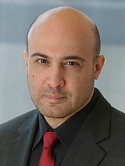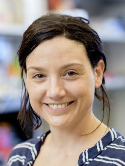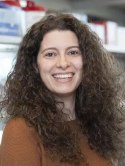Role of clonal inflammatory microglia in histiocytosis-associated neurodegeneration Journal Article
| Authors: | Vicario, R.; Fragkogianni, S.; Pokrovskii, M.; Meyer, C.; Lopez-Rodrigo, E.; Hu, Y.; Ogishi, M.; Alberdi, A.; Baako, A.; Ay, O.; Plu, I.; Sazdovitch, V.; Heritier, S.; Cohen-Aubart, F.; Shor, N.; Miyara, M.; Nguyen-Khac, F.; Viale, A.; Idbaih, A.; Amoura, Z.; Rosenblum, M. K.; Zhang, H.; Karnoub, E. R.; Sashittal, P.; Jakatdar, A.; Iacobuzio-Donahue, C. A.; Abdel-Wahab, O.; Tabar, V.; Socci, N. D.; Elemento, O.; Diamond, E. L.; Boisson, B.; Casanova, J. L.; Seilhean, D.; Haroche, J.; Donadieu, J.; Geissmann, F. |
| Article Title: | Role of clonal inflammatory microglia in histiocytosis-associated neurodegeneration |
| Abstract: | Langerhans cell histiocytosis (LCH) and Erdheim-Chester disease (ECD) are clonal myeloid disorders associated with mitogen-activated protein (MAP)-kinase-activating mutations and an increased risk of neurodegeneration. We found microglial mutant clones in LCH and ECD patients, whether or not they presented with clinical symptoms of neurodegeneration, associated with microgliosis, astrocytosis, and neuronal loss, predominantly in the rhombencephalon gray nuclei. Neurological symptoms were associated with PU.1+ clone size (p = 0.0003) in patients with the longest evolution of the disease, indicating a phase of subclinical incipient neurodegeneration. Genetic barcoding analysis suggests that clones may originate from definitive or yolk sac hematopoiesis, depending on the patients. In a mouse model, disease topography was attributable to a local clonal proliferative advantage, and microglia depletion by a CSF1R-inhibitor limited neuronal loss and improved survival. These studies characterize a neurodegenerative disease associated with clonal proliferation of inflammatory microglia. The long preclinical stage represents a therapeutic window before irreversible neuronal depletion. © 2025 memorial sloan kettering cancer center |
| Keywords: | immunohistochemistry; survival; mitogen activated protein kinase; adult; controlled study; aged; middle aged; unclassified drug; gene mutation; human cell; genetics; histopathology; nonhuman; transcription factor foxp3; animal cell; mouse; phenotype; animal; metabolism; animals; mice; animal tissue; cerebellum; interleukin 1beta; animal experiment; animal model; astrocyte; gliosis; inflammation; gene frequency; pathology; immunoreactivity; retrospective study; central nervous system; disease model; cerebrospinal fluid; blood sampling; gabaergic transmission; cd11b antigen; cognitive defect; histiocytosis; autopsy; disease models, animal; phagocytosis; rhombencephalon; fluorescence activated cell sorting; liver biopsy; neuron specific nuclear protein; b raf kinase; alzheimer disease; degenerative disease; colony stimulating factor 1; interleukin 1; nerve degeneration; neurodegeneration; neurodegenerative diseases; hippocampus; dna methyltransferase 3a; langerhans cell histiocytosis; afimoxifene; complication; microglia; gray matter; mosaicism; brainstem; potassium chloride; topography; pons; mapk pathway; dna barcoding; oxygenase; histiocytosis, langerhans-cell; chemokine receptor cx3cr1; medulla oblongata; clonal hematopoiesis; high throughput sequencing; granulocyte macrophage colony stimulating factor receptor; receptors, granulocyte-macrophage colony-stimulating factor; astrocytosis; n [3 (5 chloro 1h pyrrolo[2,3 b]pyridine 3 carbonyl) 2,4 difluorophenyl]propanesulfonamide; humans; human; male; female; article; complement component c1q; erdheim chester disease; differential expression analysis; magnesium chloride; 4',6 diamidino 2 phenylindole; resident macrophages; triton x 100; receptor type tyrosine protein phosphatase c; jak-stat signaling; digital polymerase chain reaction; single cell rna seq; chromatin immunoprecipitation sequencing; tet methylcytosine dioxygenase 2; asxl transcriptional regulator 1; xanthelasma palpebrarum; 4 dimethylaminoazobenzene; complement component c1q antibody; plx5622 colony forming factor inhibitor |
| Journal Title: | Neuron |
| Volume: | 113 |
| Issue: | 7 |
| ISSN: | 0896-6273 |
| Publisher: | Cell Press |
| Date Published: | 2025-04-02 |
| Start Page: | 1065 |
| End Page: | 1081.e13 |
| Language: | English |
| DOI: | 10.1016/j.neuron.2025.02.007 |
| PUBMED: | 40081365 |
| PROVIDER: | scopus |
| PMCID: | PMC12459608 |
| DOI/URL: | |
| Notes: | Article -- MSK Cancer Center Support Grant (P30 CA008748) acknowledged in PDF -- MSK corresponding author is Frederic Geissmann -- Source: Scopus |
Altmetric
Citation Impact
BMJ Impact Analytics
MSK Authors
Related MSK Work

















